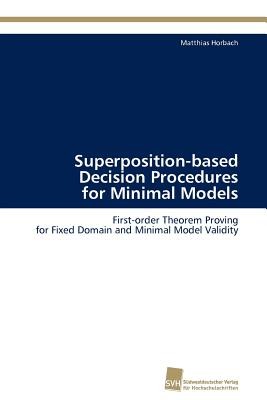
- We will send in 10–14 business days.
- Author: Horbach Matthias
- Publisher: Sudwestdeutscher Verlag Fur Hochschulschriften AG
- Year: 2011
- Pages: 216
- ISBN-10: 3838128028
- ISBN-13: 9783838128023
- Format: 15.2 x 22.9 x 1.2 cm, softcover
- Language: English
- SAVE -10% with code: EXTRA
Superposition-based Decision Procedures for Minimal Models (e-book) (used book) | bookbook.eu
Reviews
Description
Superposition is an established decision procedure for various first-order logic theories represented by clause sets. A satisfiable theory, saturated by superposition, implicitly defines a minimal Herbrand model. This raises the question in how far superposition can be employed for reasoning about such models. This is indeed often possible when existential properties are considered. However, proving universal properties directly leads to the introduction of Skolem functions and a modification of the minimal model's term-generated domain, changing the examined problem. The author Matthias Horbach describes the first superposition calculus that can explicitly represent existentially quantified variables and that in consequence can compute with respect to a given fixed domain. It does not eliminate existential variables by Skolemization but handles them using additional constraints with which each clause is annotated. The calculus is sound and refutationally complete in the limit for a fixed domain semantics. For special classes of theories, it is even complete for proving properties of the minimal model. It thus gives rise to various decision procedures for minimal model validity.
EXTRA 10 % discount with code: EXTRA
The promotion ends in 20d.08:16:09
The discount code is valid when purchasing from 10 €. Discounts do not stack.
- Author: Horbach Matthias
- Publisher: Sudwestdeutscher Verlag Fur Hochschulschriften AG
- Year: 2011
- Pages: 216
- ISBN-10: 3838128028
- ISBN-13: 9783838128023
- Format: 15.2 x 22.9 x 1.2 cm, softcover
- Language: English English
Superposition is an established decision procedure for various first-order logic theories represented by clause sets. A satisfiable theory, saturated by superposition, implicitly defines a minimal Herbrand model. This raises the question in how far superposition can be employed for reasoning about such models. This is indeed often possible when existential properties are considered. However, proving universal properties directly leads to the introduction of Skolem functions and a modification of the minimal model's term-generated domain, changing the examined problem. The author Matthias Horbach describes the first superposition calculus that can explicitly represent existentially quantified variables and that in consequence can compute with respect to a given fixed domain. It does not eliminate existential variables by Skolemization but handles them using additional constraints with which each clause is annotated. The calculus is sound and refutationally complete in the limit for a fixed domain semantics. For special classes of theories, it is even complete for proving properties of the minimal model. It thus gives rise to various decision procedures for minimal model validity.


Reviews